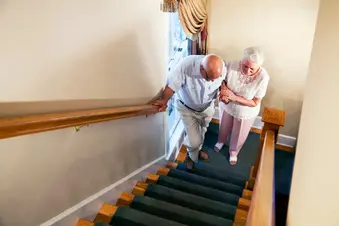
Perhaps no movie has better staying power than Willy Wonka and the Chocolate Factory. Many of us raised our children -- and now our grandchildren -- on the 1971 hit. In a movie filled with iconic scenes, one that really resonates with me involves Charlie’s four grandparents.
It’s hard to forget Grandpa Joe being confined to a bed as life in the house goes on around him. He’s seemingly living out his later years as a passive observer -- that is, until Charlie brings home the golden ticket. He chooses Grandpa Joe to come with him to the mysterious factory. Consequently, Grandpa Joe pops out of bed for the first time in 20 years, and a song and dance naturally ensues. Orchestral strings and horns soundtrack the family’s joy, as the impossible comes true.
What Does It Say About Our Assumptions of Older People and Their Ability to Get Around?
The scene is truly an iconic moment in cinema history, but what does it say about our assumptions of older people and their ability to get around? A magical golden ticket -- a once-in-a-lifetime opportunity -- should not be needed to get up and moving.
Unfortunately, this was our approach to mobility for too long. Older patients’ deteriorating mobility was taken as inevitable, so if the doctor prescribed a medication or ordered a procedure that had a negative impact on a patient’s function, it was seen as the cost of doing business.
Thankfully, that mindset is changing.
Changing Attitudes About Mobility
Hospitals and health systems participating in The John A. Hartford Foundation and the Institute for Healthcare Improvement’s Age-Friendly Health Systems initiative prioritize older patients’ mobility in the planning and delivery of care.
Christiana Care in Delaware, for example, launched an initiative called Activity and Mobility Promotion, which gets hospital patients up and moving every day. It’s a departure from the historical tendency to keep patients in bed for fear of falls and other negative consequences. Getting hospital patients up and moving with the help of their care teams can prevent muscle atrophy, ulcers, respiratory complications, and other negative effects of bed rest. It can also reduce the risk of patients being readmitted to the hospital shortly after discharge.
Change is also happening in California within the Kaiser Permanente system, where teams of doctors, nurses, and other clinicians are developing innovative mobility solutions.
At Kaiser, they’ve incorporated range-of-motion exercise worksheets into the care of older patients at the Canyon Oaks skilled nursing facility for patients going through rehabilitation. The worksheets guide patients and their caregivers through exercises throughout the day, so they get stronger, more limber, and home sooner -- something that often matters most to many older patients.
Older adults in the Presbyterian Senior Care Network are caring for plants as a way to maintain and increase mobility. The residents are responsible for the care of the plants, including proper potting, watering, and ensuring they are receiving an appropriate amount of sun. This gets residents up and moving about in a safe, mentally engaging way.
These and other hospitals and health systems in the Age-Friendly Health Systems initiative focus on older patients’ mobility as just one part of the 4Ms framework that guides the initiative. The others include focusing on what matters (aligning care with each patient’s specific care goals and preferences); mentation(preventing, identifying, treating, and managing dementia, depression, and delirium) and medication (using medications that don’t interfere with what matters to patients, their mobility, or mentation).
While remakes didn’t work out so well for the Willy Wonka franchise (sorry, Johnny Depp), they are a welcomed and necessary innovation in health care. Systems are rethinking the way they care for older patients to prioritize what matters to them, rather than what’s the matter with them, resulting in improved patient care, outcomes, and satisfaction.
As a patient, you have the right to demand and receive age-friendly care that respects what matters to you, including your mobility.
For more resources on age-friendly care, visit johnahartford.org/agefriendly.
(A version of this article, by Terry Fulmer, PhD, RN, FAAN, president of The John A. Hartford Foundation, originally appeared on Next Avenue.)
Show Sources
Photo Credit: E+ / Getty Images